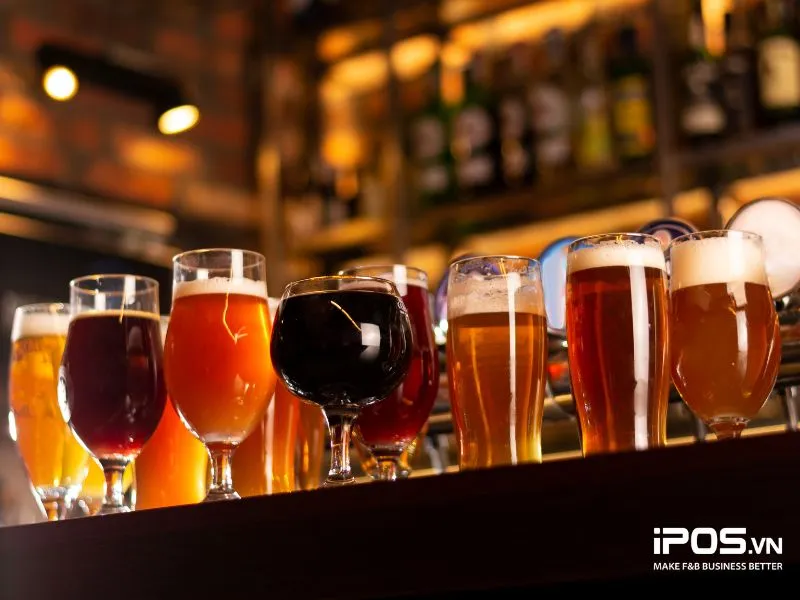Craft beer, a refreshing breeze introduced to the Vietnamese beer market in the mid-2010s, is not just a beverage but a symbol of creativity and passion. Despite fierce competition from industrial beer brands, craft beer has managed to carve out its own niche and continue flourishing. So, what makes Vietnamese craft beer so special and appealing? Let’s dive in!
What Is Craft Beer?
Craft beer is a type of beer brewed using traditional methods, featuring unique recipes and a special focus on flavor. Unlike mass-produced industrial beer, craft beer is made with meticulous care to ensure high quality and distinctive tastes.
The production process for craft beer usually takes place in small breweries or even home-based setups, with batch sizes typically under 1,000 liters to maintain the best quality.
Craft beer is primarily made from purified water, hops, malt (or other grains), and yeast. Craft brewers often innovate by adding ingredients like fruits, coffee, or herbs to create unexpected and unique flavors.
Born in late 1970s England, craft beer triggered a revolution in the beer industry, transforming how consumers perceive this beloved libation. Craft beer is not just a drink—it represents creativity and passion in the art of brewing.
Popular Craft Beers in Vietnam

Since arriving in Vietnam around 2015-2016, craft beer rapidly became a trend embraced by beer enthusiasts. Its diversity and richness in flavor are key factors driving the appeal of Vietnam’s craft beer culture. Below are some popular types of craft beer widely enjoyed in Vietnam:
- Pale Ale: A signature from East West Brewing, Pale Ale strikes the perfect balance between German malt flavors and hops from the U.S. and New Zealand.
- IPA (India Pale Ale): Originating from England, IPA is famed for its strong bitterness due to high hop content. It’s ideal for those seeking bold beer flavors.
- Burnin’ Down The House Double IPA: A unique offering from Pasteur Street Brewing, this Vietnamese-inspired beer combines citrus, honey, and rambutan for an easy-drinking and balanced flavor profile.
- East Sea: Crafted by Platinum Beers, East Sea blends tropical fruits with bold hop aromas, offering a refreshing and unique experience.
- Golden Ale: Brewed by BiaCraft, Golden Ale is perfect for Vietnam’s climate, boasting mild and easy-drinking flavors.
The Growth Potential of Vietnam’s Craft Beer Market
Vietnam’s craft beer market is thriving, steadily gaining presence and expanding its reach. This growth is driven by several promising factors.
A Promising Market
Globally, craft beer has become a highly popular trend, celebrated not just as a drink but as a cultural and culinary phenomenon.
According to Brewers Association, craft beer sales in the U.S. have doubled over the past decade, while industrial beer sales have significantly declined.
In Asia, craft beer markets are booming in countries like Japan, South Korea, China, and Vietnam. Vietnam, in particular, is seen as a “paradise” for craft beer lovers, drawing investment from brewers who aim to establish production facilities thanks to market advantages, labor costs, and ingredient availability.
The rise in bars, restaurants, and the tourism industry further accelerates craft beer’s growth in Vietnam.
Favorable Legal Environment
Vietnam offers a relatively relaxed regulatory environment for craft beer producers. They are permitted to brew in small batches, fostering creativity and experimentation—a contrast to certain countries where large-scale production requirements impose limitations.
Changing Consumer Habits

New consumer generations are paying more attention to product quality, unique flavors, and locally sourced offerings. Modern drinking culture is shifting focus from “drinking to get drunk” to “drinking for enjoyment and experience.”
Particularly, Gen Y and Gen Z show increasing preference for high-quality, locally-made products that also emphasize health benefits. This presents significant opportunities for craft beer producers, as each craft beer offers a unique combination of color, alcohol content, bitterness, flavor, and aroma.
Customers can choose their preferred taste, making craft beer distinctive compared to industrial beer’s uniform flavors. Drinking craft beer is also seen as a way to showcase individuality and style.
Tips for Starting a Craft Beer Bar
Thanks to Vietnam’s promising opportunities, many investors have opted to establish craft beer bars in major cities. Below are some valuable tips to consider before jumping into this venture:
- Initial Investment: Craft beer is generally considered a premium product targeting discerning drinkers, requiring substantial upfront investment—often in the hundreds of millions of VND. The specific budget depends on factors like scale, location, staff quality, and more.
- Business Licenses: Craft beer establishments need proper licensing, such as permits for retail alcohol sales, food safety certifications, tax declarations, and fire safety approvals.
- Location: The venue’s location plays a crucial role in success. Opt for central areas with high population density and urban vibrancy. However, rental costs in such areas may be quite high.
- Beer Quality & Storage: Quality is key to attracting and retaining customers. Partner with reputable suppliers and learn proper craft beer storage techniques to ensure freshness and consistency.
- Food Pairing Menu: Side dishes enhance the beer-drinking experience and serve as an important competitive edge. Create a diverse and appealing menu based on customer preferences.
- Hiring & Training Staff: Staff should be knowledgeable about beer products, possess good communication skills, and maintain professionalism.
- Marketing Budget: Promote your craft beer bar with strategic marketing campaigns, often accounting for around 5-7% of total investment costs.
- Sales Management Software: Utilize sales management tools to streamline order processes, payment handling, revenue tracking, and minimize errors.
Conclusion
Craft beer in Vietnam is more than a beverage—it’s a unique cultural and culinary experience. With the creativity of local brewers and the enthusiasm of consumers, Vietnam’s craft beer market is poised for strong growth in the future. If you’re considering entering this market, prepare thoroughly to tap into its exciting opportunities and achieve success.